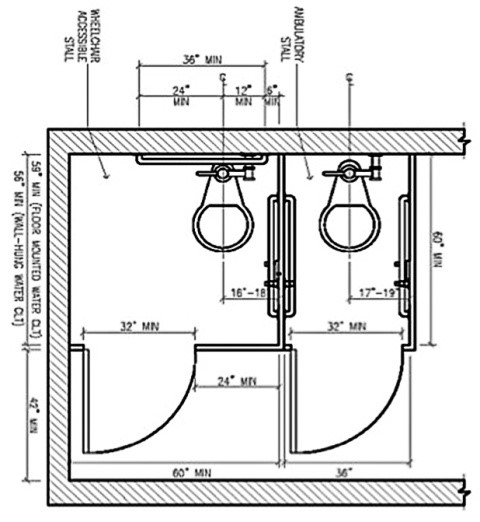

Tip: If you’re already knocking down walls to make the hallways wider, consider doing the same for doorways. When a wall needs to be moved, it’s a good idea to follow guidelines from the Americans with Disabilities Act (ADA) standard of 48” in width. We recommend finding a contractor with experience in building wheelchair accessible homes and structures. If a hallway is not wide enough, homeowners may want to consider renovating the home so the hallways are wider. Where clearance is minimal, removing large or low hanging artwork from walls may be necessary. This can include side tables, coat trees, shoe racks, and decorative items. One of the easiest steps to take in making hallways wheelchair accessible is to clear the hall of any potential obstacles. If a turn is necessary to enter a room that is along a hallway, 36" clearance or more will be needed in all directions for enough room to make the turn unimpeded. Keep in mind, this is for a straight entrance-way to a hallway where no turns are needed. The minimum width for a hallway to accommodate a wheelchair is 36”, however, 48" is considered to be the ideal minimum and is required by law in most commercial establishments.

Common barriers include door width and door thresholds because they can narrow down the space to pass through and make it difficult to move from one surface to another. If a person with a disability sees that the business has not met ADA compliance, they may be able to take legal action.Depending on the type of floor plan your home has, doorways may be the number one interior obstacle. Visitors to public establishments are protected under ADA law. ADA-compliant door hardware should open with one hand and be 34 to 48 inches above the floor. Doors that only security personnel can open do not have to follow the guidelines. Doors that open 90 degrees should have a minimum 32-inch opening. Doorsĭoors are also required to be accessible to wheelchair users. Halls that change levels of more than half an inch are required to have platforms or ramps. The ADA requires carpets to be securely fastened with a maximum pile of half an inch and strips along the exposed edges. Surface and floors of hallways must be covered with non-slip materials to prevent falls. If a commercial building has part of an accessible intersection with less than an 80-inch clearance, a barrier should be put in place.

The ADA requires a clearance of 80 inches to help blind and disabled people prevent injuries from head bumps. All types of checkout aisles must have an accessible lane. Checkout lanes must be at least 36 inches wide and should include the international wheelchair-accessible sign. Checkout lanesĬheckout lanes have their own guidelines. The ADA states that a T-intersection passes requirements. The passing intervals should measure 200 feet minimum. The ADA requires 60 inches minimum width for passing with passing intervals reasonably spaced. Hallways should include enough space for wheelchair users and others to pass each other comfortably. It requires that halls measure no less than 36 inches wide for commercial establishments, and the halls must provide a clearance space for turns. The Americans With Disabilities Act sets guidelines that facilities in California must follow to make hallways wheelchair accessible.


 0 kommentar(er)
0 kommentar(er)
